 |
  |
 |
  |
Chidaakaasham: Myriad Expressions of Art (Day 2) - A.M. Hari Shankar e-mail: hshankar252@gmail.com February 11, 2021 Chidaakaasham: Myriad Expressions of Art (Day 1) The second day's session started with another super set of artistes and scholars. Prof. Deepti Omchery Bhalla: Moods and Expressions in the Rhythms and Melodies of Kerala 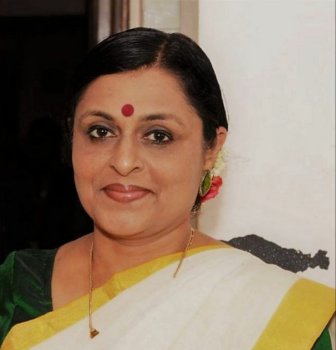 Prof. Deepti Omchery Bhalla A rare combination of dancer, singer, and researcher, her works in Sopana sangeetham always stood unique for its strict adherence to the traditional way of rendering the temple compositions. She started with a short video of legendary Kottipaadi Sevakar Chembumpuram Krishnankutty with his disciple Amabalapuzha Vijayakumar singing tyaanis or dhyaanis (temple hymns). Bhava and taala find a very prominent place in the performative traditions of Kerala. The traditional music of Kerala, Sopana sangeetham is a dramatic music with a religious fervor with more emphasis of musical expressions that enhances bhava. This bhava aspect reigns supreme in all major performative and ritualistic traditions of Kerala. The descriptions of the deity, the ragas, taalas can be seen in the tyaanis or dhyaana shlokas (considered as a meditative process) used in kottipaadi seva or temple service singing. The temple drummers or Marars sing along with keeping the taala in edakka. For invoking the deity, the taala and raga must adhere to the time. She demonstrated this with chollus of this tradition which she has used in her choreography in three distinctive styles of the same taala. In triputa taala of 7 beats, the mode of expression remains distinct from the one in Carnatic style. This triputa taala varies in Kottipadi seva (eddakka kooru), in stage performances and theatre presentations and in folk performances varies with how the naada that comes out from different instruments, the rendering of the vaytharis are also varied and modified. Starting with Panchari 6 beat cycle and then going to 7 beat cycle, Arjunanritham or Mayilpeelithookam is rustic folk performing art, the vaytharis (chollus) of which she has incorporated in her Mohiniyattam production but as it is a rustic art form and Mohiniyattam being a soft, lyrical art form, the incorporation cannot be done per se, and slight modifications are required before taking that to Mohiniyattam. Commenting upon the distinctive feature of Kerala music and taala paddhathi, she pointed out the soft sounding of a taala or beat to raagalaapana enhancing emotive appeal of singing compositions. Existence of Touryathrikam, i.e., geetham, vadyam, nrittam continues to exist in performative folk art forms of Kerala like Padayani and Thullal. Chandobadhareethi with the shashabda (sounded) and nishabda kriya (unsounded) mode of taala expression is found very much adopted in the traditional Kerala art forms, where the duration of both remains the same. The gradual ascend in the tempo from the slowest to highest is one of the most distinctive features of Kerala music tradition, especially in temple music which is no way similar to the laya concept of vilamba, madya, dhruta in Carnatic music, but more of a Hindustani mode of extenuation of the rhythmic patterns. The swaras and ragas suited for rasa and bhava depictions are prescribed in the Kerala traditional theatre art forms for abhinaya. For instance, Paadi raga for sringara nayakas who are essentially asuras in Kathakali, Neelambari for karuna, Madyamavathi for vichara padams. There is equal importance of taala and laya for rasabhinaya. In Koodiyattam, particular taala for particular bhava can be observed, for example, dhruva taala for bhoothabhinaya or bhayanaka. In Mohiniyattam also, Kamodari raga in vilamba kala is for sringara rasa, in madyama kala for veera rasa. Laya and raga are also important for Rasavaividya. The subtlety of nadas, amplification, intensity, frequency, timbre, tone contributes to the myriad of expressions experienced by the listener and observer. The three levels of the body, aadi (bottom), madhya, taara (above head) are connected to three sounds that we hear in nature as surging sounds of the ocean, kettle drum and jharjara, second mardala, shankhakhanda and kaahala and the third being kinkini vamsa veena bhramara. She has choreographed a mind blowing item encompassing all these aspects in triputa taala, with edakka kooru and chempada maddalam. The second Chera Empire during the 11th and 12th century was the golden era for Sanskritian Kerala. King Kulashekara presented plays on the principles of dhwani. Deeper presentations were conducted for viewers giving more ample scope for actor on stage to recapitulate past character, events which provided more opportunity to expand, innovate, and improvise for the artistes. Angika, satvika, netraabhinaya were also imbibed into the art of Mohiniyattam. Deepti presented one of her choreograph recording in which she used Guru chempa taala which would suit the Surutti raga eloquently even though chempada or adi taala can also be set. The presentation by this doyen unfurled many unknown themes and aspects specifically pertaining to Kerala Sopana sangeetham for which one whole day wouldn't be enough. Dr. Padmaja Suresh: Bharatanatyam Choreography/Metaphysical Aspects of Sound 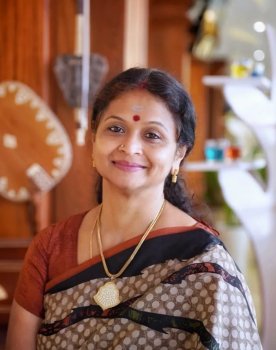 Dr. Padmaja Suresh Bangalore based dancer Padmaja Suresh is known for the versatility of her Bharatanatyam presentations by incorporating spiritual content in it. Her analysis of Margam format of Bharatanatyam as a very conventional mode of going from gross level to the subtlest level which touch that deepest vibratory point as is in the central piece of varnam also. By the dissolution from outer to inner voice to returning to the grossest level, Margam gives ample scope, the process of which grows different. Her performances were based on how to touch the roots. Samanya, Guhya level - sahitya scope to Samadi - goal to reach highest consciousness of samadi feeling. Sublimation of the artiste with the nadayogi becoming one with the incomparable joy of song and dance because of the expansion of mind. Rasovaisaha - one's own form in the dance as said in Upaadaana and Nimitta Upanishad. The force of spanda is realized as it manifests joy, fear, love and gradually ascends surpassing the individual identification with the character or the mood - Chit Eka Rasa. This rasa, spanda and ananda overcome the limitations of these emotions which have a level of difference like joy of sadness, tears, fear to the ultimate level which is in tandem with the universal resonance - one eka chitta. Prana, the life force is the intermediary between body and mind - the sound to this esoteric journey. Uchhara is the natural characteristic of expanding the stages, vocal cords, speaking or singing. The source of this rests in mooladhaara and serpent risen spontaneously in merudanda with the Nada Yoga. Sattva gets exalted. Shiva is aware of shivam through sakthi, ta dhinamthom as mentioned in the Naatyopanishad. Abhinavagupta says one varna in the form of naada in which all varnas /letters are latent, ceaseless, inarticulate, unstruck, uncaused. Bhairavatantra says an artiste is aware of the meditative levels within which it is internalized. A contemplated in the navel, U in the heart, M in the mouth. Bindu, a point in the aum is the concentrated energy of the word. Nirodhini where there is subtlety of 1/8th of a matra, Anaahata Naada, where it is 1/16. As per the Svachhanda Tantra, there is none who sounds it voluntarily, nor can anyone prevent it being sounded. The deity in the heart sounds it himself. The concept of Nadanta, an aspect of energy beyond nada as said in Brahmarandhra, subtlety is in 1/32 of a matra after which the sense of identification with the body disappears. Evolution of sound as Bheda-Bahedabheda-Bheda has sthula, sukshma and para aspects. Abhinavagupta says Aalapana-sthula pashyanti, beauty in absence of division by letters, taking the listeners to the stage of transcendence. Even for the dancers, Chaturvidha abhinaya, vibhava, anubhava, sanchari suggests the sthayin - unity of stages of sound. She depicted the mudras for mooladhara, manipuram, vishuddhaa, sahasraara, naada to shabda brahman. She also shared her videos on some of her productions like 'Nada to Akshara Varnam,' 'Praana Nyaasa-inner voice', 'Ananda Lasya Tandava,' 'Shrishti Samhara.' The extent to which these topics were understood by the listeners remains a question, although many of these concepts were aptly presented in the recordings she included along with demonstrations by her disciple, Aparna Doddamalur. Anoor Ananthakrishna Sharma: Framing nadais for rare taalas 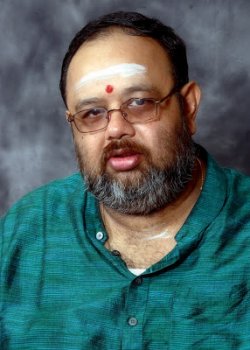 Anoor Ananthakrishna Sharma A stalwart in the field of Indian percussion, Anoor Ananthakrishna Sharma was assisted in Konnakol by his disciple Somasekhar Joy. They demonstrated three rare taalas, namely chatusrajaati dhruva taalam, sankeerna chaapu composed in a complex way of starting from the tisra gati and later aligning to the chaturasra gati itself. They concluded with adi talam in mishra gati. Demonstrations included setting of the nadai playing along with mohra, korvai and aruthi in very intricate patterns and format. Both guru and disciple improvised live in the webinar making it more interesting and engaging. Subramanian Chidambaram: Vedic Chandhas and recitation techniques 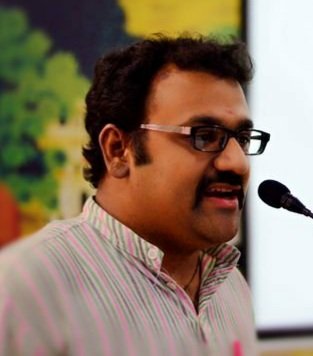 Subramanian Chidambaram The topic being very vast, he tried to introduce the concept of chandhas in the Santana dharma, i.e., Vedic dharma. Everything begins from Veda shastras. Vedangas are the supplementary tools to understand the Vedas which are 6 in number - Shiksha, Vyakarana, Niruktha, Chandas, Jyothisha and Kalpa. Shiksha deals with the phonetics or phenology, how to utter the alphabets or sound. Rishis saw Veda and gave us a particular devata in a metrical form or metre, which is called chandas. From there, originates the kalapramana and taala from the Vedas itself given to us by the Supreme Being. Prayoga is where to be used - "Rishi devata chandas prayoga". Veda purusha has different angas, the legs are the chandas, Jyothisha-eyes, kalpa-hands, niruktham- ears. In Amarakosha, "Chandate iti adeh chandas" (That which gladdens the devata is chandas). In fact, chandas means metre, but themselves are called chandas as they are completely in metrical form and they are primeval literature. That's why, Vedas are also called Chandas. 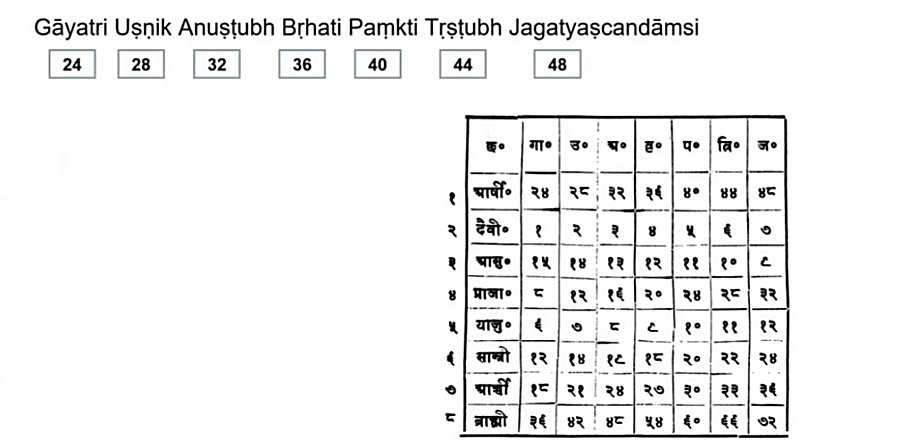 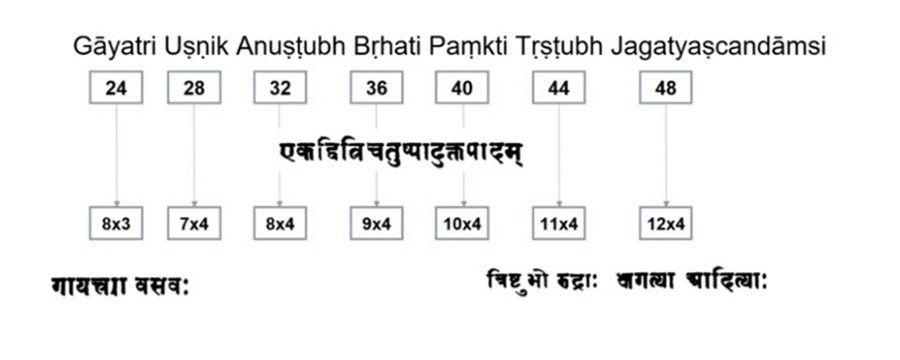 Chanda Shastra by Rishi Pingala, "Chandaha shabdene akshara sankyavath chandaha abhideeyathe" (More usable meaning of chandas. How many aksharas are there in that particular meter indicated by the term chandas.) 7 meters or chandas: "Gayatri Ushnik Anushtubh Brhati Pamkti Tristubh Jagatyascandaamsi" (Gayatri 24, Ushnik 28, Anushtubh 32, Brhati 36, Pamkti 40, Tristubh 44, Jagaty 48). More permutations and combinations are possible. The one above is Aarshi or Rishiproktha Chandas. Daivi, Asuri, Paraajapathya, Aarshi, Rajushi, Brahmi are varying alphabets or letters. If (-1) it's Nichrith,- 2 viraat, +2 kwaraat, +1 bhoorik The verses when chanted in these meters are divided into sections or paadas of the verse. It could be 1,2,3,4 variations. Gaythri having 3 paadas each having 8 aksharaas. Ashtaaksharaas, 8X3=24. Similarly, 7, 8,8. We have in Pingala sutras, 11 (Ekadesa Rudra, therefore Tristubha rudra), 8 (Gayathrya vasava, ashta vasus/Ashtaksharas), 12 (Adityaaha. therefore jagatsyaha aadityaaha). Melakartha system - indu/agni chakra. 1 indu 1 chakra, netra 2 chakra. 8x3 can also be 6x4, that variation also exists (6 by rithus / seasons). Each chanda is related to a particular devata. "Mantradhistitaha devah" in the form of mantras, the devata manifests itself. The right way of chanting niruktha, vyakarana, chandas, Vedangaas, jyotisha, kalpa, Gayatri -agni, they relate chandas to sapta swaras. Vedas are oral tradition maukhika parampara, by which they are bound to errors. Suiting the voice, variations, different techniques for preservation of Vedic recitation were devised. He explained with a popular rig in Jagati Kramapaata (1-2,2-3,3-4,4-5), Padapaata (9) broken down into padaas. Vikriti techniques are just going back and forth. Ghanapaata (1-2;2-1;1-2-3;3-2-1). A good background knowledge of these aspects was a pre-requisite for a clear understanding but Subramanian was able to at least introduce these concepts eloquently. His famed online platform 'Subbu's corner' has an exquisite collection of the interviews he has conducted with some noted scholars and musicians. Monisa Nayak: Taala Aakriti / The Pulse of Kathak  Monisa Nayak A very promising artiste, Monisa Nayak started with the concept of first cosmic sound and rhythm borne in Shiva's damaru. Rhythm or taala is made up of two aspects -tandava and lasya. Rhythm is important to give balance in any kind of music. Laya encompasses all aspects of rhythm, taala is the system evolved to measure laya. A good grip of laya is important for all dance styles especially for Kathak, with taala as the very pulse and center of Kathak. Timed movements through space in visual representation can be observed in this repertoire. Three types of rhythms can be observed in Kathak. Regular rhythm occurs when intervals between the elements are similar in size and length, intervals can be varied by changing the pace of the rhythm. Flowing rhythm when the elements are organic, naturally created feeling of movement. Progressive rhythm when a sequence of movements through progression generates different variation both in lyrics and abstract syllables. Gatibhava on rhythmic structure and syllables. She demonstrated this with Koormavathaara. The history of every dance plays a very important role in the development of its repertoire. It was Mughal era for Kathak. Mughal miniature paintings have contributed a lot to the structuring of Kathak. Painting and dance possess similar principles such as pattern, emphasis and balance, rhythm. Role of allied arts in Kathak is worth mentioning. The geometrical and intrinsic patterns, colors and also these characteristics can be observed in any art form. Kathak also developed as a linear dance form like other classical dance forms. The modern system of Kathak in which there is more intricate measurements of time is because of Indo Persian culture fusion. There are doubles, 4,8 times and more and more fractional measurements like we see in these paintings, having many similarities to yathis (Arrangement of syllables into a beautiful combination that gives particular shape to music) in Indian classical system. Eg. Sama Yati she related to the painting, Shrotoyaka Yati (river form, short to broader) compared to the design in a painting, Mridanga Yati (small to big to small). Geometry is seen in cosmos, astronomy, astrology; prakriti and purusha get aligned in nature, taking both the performer and the observer to an unknown terrain of high artistic and spiritual experience. Dr. Sumathi Krishnan: Valedictory address 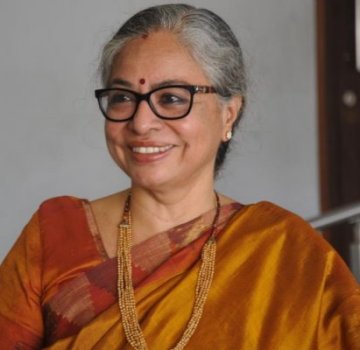 Dr. Sumathi Krishnan A whole separate session was required for getting deep knowledge from this fine artiste. She said it's all about naada, the sound that is produced. Unless the naada envelops the entire space, there will be no impact on audience. She talked on Varnams. Chauka varnams, slow-chauka, and unlike the taana varnams where there are syllables, here like raagalaapana in multiple speeds combined together. Stress syllables in varnams are made in separation of musical phrases, rhythmic in nature, Mohana Varnam by Pallavi Doraswamy Iyer, in varnam Pankajakshi in Kamboji by Mahavaidyanathar Shivan, where Damaru Yati with similar sahityam can be seen, a sense of perfect proportion in nature. Kalapramanam do not lend themselves in speed e.g. Sahana, Devagandhari for emotions and bhava. Kunthalavarali is always set in speed. Desadi taala Tyagaraja compositions can be taken as an example. The speed of feel is different even if the tone scale is similar. When there are less kriya, it gives a feel of slowness. In Chidambaram, chit sabha, ponnambalam kanaka sabha, 21600 gold plates representing breaths in a lifetime with 72000 nails to hold this indicating 72000 nerves nadis, are held by 64 beams referring to 64 kalas as mentioned in sutras. Spiritual, metaphysical, ritualistic aspects were interconnected in this two day Chidaakaasham seminar. The organizers Prof. Deepti Omchery Bhalla and Dr. Padmaja Suresh expressed their vote of thanks to all the participants and scholars as the session concluded. The two day brain storming webinar found its purpose with quite a large number of participants actively involved in 3 to 4 hours per day of these sessions. Seminars of this repute serve as the milestones especially for the young upcoming generation to pursue art with utmost importance and responsibility. 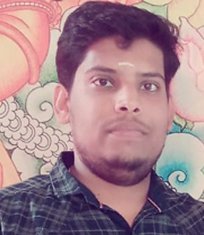 Delhi based A.M. Hari Shankar currently working as an Editor in a leading publishing company by profession, is a percussionist and an art enthusiast by passion. Post your comments Pl provide your name and email id along with your comment. All appropriate comments posted with name and email id in the blog will be featured in the site. |